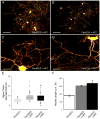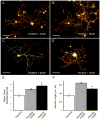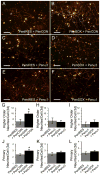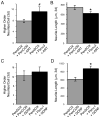Increased Expression of Transcription Factor SRY-box-Containing Gene 11 (Sox11) Enhances Neurite Growth by Regulating Neurotrophic Factor Responsiveness
- PMID: 29746989
- PMCID: PMC5972070
- DOI: 10.1016/j.neuroscience.2018.04.037
Increased Expression of Transcription Factor SRY-box-Containing Gene 11 (Sox11) Enhances Neurite Growth by Regulating Neurotrophic Factor Responsiveness
Abstract
The peripherally projecting axons of dorsal root ganglion (DRG) neurons readily regenerate after damage while their centrally projecting branches do not regenerate to the same degree after injury. One important reason for this inconsistency is the lack of pro-regeneration gene expression that occurs in DRG neurons after central injury relative to peripheral damage. The transcription factor SRY-box-containing gene 11 (Sox11) may be a crucial player in the regenerative capacity of axons as previous evidence has shown that it is highly upregulated after peripheral axon damage but not after central injury. Studies have also shown that overexpression or inhibition of Sox11 after peripheral nerve damage can promote or block axon regeneration, respectively. To further understand the mechanisms of how Sox11 regulates axon growth, we artificially overexpressed Sox11 in DRG neurons in vitro to determine if increased levels of this transcription factor could enhance neurite growth. We found that Sox11 overexpression significantly enhanced neurite branching in vitro, and specifically induced the expression of glial cell line-derived neurotrophic factor (GDNF) family receptors, GFRα1 and GFRα3. The upregulation of these receptors by Sox11 overproduction altered the neurite growth patterns of DRG neurons alone and in response to growth factors GDNF and artemin; ligands for GFRα1 and GFRα3, respectively. These data support the role of Sox11 to promote neurite growth by altering responsiveness of neurotrophic factors and may provide mechanistic insight as to why peripheral axons of sensory neurons readily regenerate after injury, but the central projections do not have an extensive regenerative capacity.
Keywords: dorsal root ganglia; molecular biology; neurite growth; neurotrophic factor; regeneration; transcription factor.
Copyright © 2018 IBRO. Published by Elsevier Ltd. All rights reserved.
Figures







Similar articles
-
Neurite outgrowth in normal and injured primary sensory neurons reveals different regulation by nerve growth factor (NGF) and artemin.Mol Cell Neurosci. 2015 Mar;65:125-34. doi: 10.1016/j.mcn.2015.03.004. Epub 2015 Mar 6. Mol Cell Neurosci. 2015. PMID: 25752731
-
SRY-box containing gene 11 (Sox11) transcription factor is required for neuron survival and neurite growth.Neuroscience. 2006 Dec 1;143(2):501-14. doi: 10.1016/j.neuroscience.2006.09.010. Epub 2006 Oct 19. Neuroscience. 2006. PMID: 17055661 Free PMC article.
-
Overexpression of Sox11 promotes corticospinal tract regeneration after spinal injury while interfering with functional recovery.J Neurosci. 2015 Feb 18;35(7):3139-45. doi: 10.1523/JNEUROSCI.2832-14.2015. J Neurosci. 2015. PMID: 25698749 Free PMC article.
-
Unleashing Axonal Regeneration Capacities: Neuronal and Non-neuronal Changes After Injuries to Dorsal Root Ganglion Neuron Central and Peripheral Axonal Branches.Mol Neurobiol. 2024 Jan;61(1):423-433. doi: 10.1007/s12035-023-03590-7. Epub 2023 Aug 24. Mol Neurobiol. 2024. PMID: 37620687 Review.
-
The role of neurotrophic factors in nerve regeneration.Neurosurg Focus. 2009 Feb;26(2):E3. doi: 10.3171/FOC.2009.26.2.E3. Neurosurg Focus. 2009. PMID: 19228105 Review.
Cited by
-
SOX11 as a prognostic biomarker linked to m6A modification and immune infiltration in renal clear cell carcinoma.Transl Cancer Res. 2024 Jul 31;13(7):3536-3555. doi: 10.21037/tcr-24-109. Epub 2024 Jul 15. Transl Cancer Res. 2024. PMID: 39145091 Free PMC article.
-
Brief Electrical Stimulation Promotes Recovery after Surgical Repair of Injured Peripheral Nerves.Int J Mol Sci. 2024 Jan 4;25(1):665. doi: 10.3390/ijms25010665. Int J Mol Sci. 2024. PMID: 38203836 Free PMC article. Review.
-
Silc1 long noncoding RNA is an immediate-early gene promoting efficient memory formation.Cell Rep. 2023 Oct 31;42(10):113168. doi: 10.1016/j.celrep.2023.113168. Epub 2023 Sep 23. Cell Rep. 2023. PMID: 37742186 Free PMC article.
-
Different Effect of Sox11 in Retinal Ganglion Cells Survival and Axon Regeneration.Front Genet. 2018 Dec 18;9:633. doi: 10.3389/fgene.2018.00633. eCollection 2018. Front Genet. 2018. PMID: 30619460 Free PMC article.
-
Neuropathic pain development following nerve injury is mediated by SOX11-ARID1A-SOCS3 transcriptional regulation in the spinal cord.Mol Biol Rep. 2024 Feb 7;51(1):281. doi: 10.1007/s11033-023-09183-w. Mol Biol Rep. 2024. PMID: 38324208
References
-
- Aigner L, Arber S, Kapfhammer JP, Laux T, Schneider C, Botteri F, Brenner HR, Caroni P. Overexpression of the neural growth-associated protein GAP-43 induces nerve sprouting in the adult nervous system of transgenic mice. Cell. 1995;83:269–278. - PubMed
-
- Baloh RH, Enomoto H, Johnson EM, Jr, Milbrandt J. The GDNF family ligands and receptors - implications for neural development. Curr Opin Neurobiol. 2000;10:103–110. - PubMed
-
- Bennett DL, Boucher TJ, Armanini MP, Poulsen KT, Michael GJ, Priestley JV, Phillips HS, McMahon SB, Shelton DL. The glial cell line-derived neurotrophic factor family receptor components are differentially regulated within sensory neurons after nerve injury. J Neurosci. 2000;20:427–437. - PMC - PubMed
Publication types
MeSH terms
Substances
Grants and funding
LinkOut - more resources
Full Text Sources
Other Literature Sources
Molecular Biology Databases

